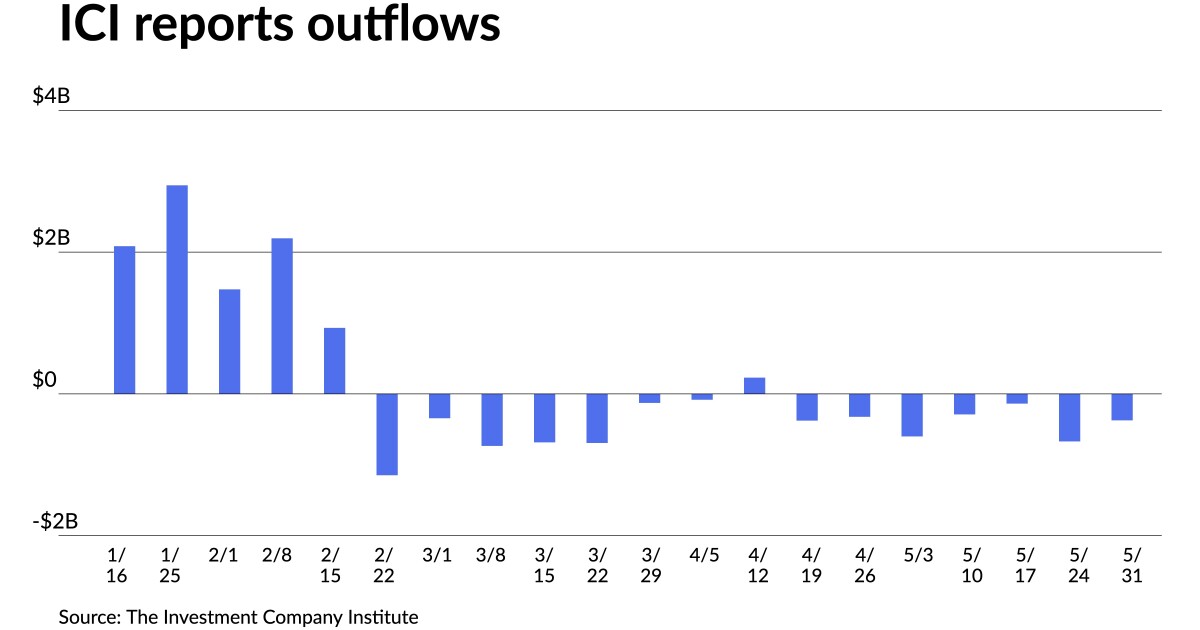Focus turns to primary, munis outperform UST
7 min read
Municipals were little changed to weaker in spots Wednesday, while U.S. Treasuries sold off after the Bank of Canada raised interest rates and equities ended mixed.
Triple-A benchmarks were cut up to three basis points, depending on the scale, while UST yields rose four to 10 basis points.
The two-year muni-Treasury ratio Wednesday was at 65%, the three-year at 67%, the five-year at 68%, the 10-year at 69% and the 30-year at 89%, according to Refinitiv MMD’s 3 p.m. read. ICE Data Services had the two-year at 66%, the three-year at 69%, the five-year at 68%, the 10-year at 71% and the 30-year at 93% at 4 p.m.
The Investment Company Institute reported investors pulled another $374 million out of municipal bond mutual funds in the week ending May 31, after $671 million of outflows the previous week. Exchange-traded funds saw inflows of $339 million after $108 million of inflows the week prior.
“A varied mix of new issues is circulating as bonds have become range-bound in early June trading,” said Kim Olsan, senior vice president of municipals at FHN Financial.
With price improvements happening on the short end of the muni curve, she said “the balance of maturities is mirroring the UST with a tight yield range.”
Munis due inside three years “have rallied as daily-reset floater rates drop on heavier money-market demand presumably from June 1 redemptions ([Tuesday’s] reset was 2.49% from 3.94% a week earlier),” she noted.
Secondary flows “have become striated between daily [Federal Deposit Insurance Corp.] liquidations and other bid list volume heavily concentrated in short-optioned bonds,” according to Olsan.
New spread ranges in the sub-4% coupon stack could be created from the FDIC lists as additional volume is forthcoming, she said.
“A bids wanteds in $3.7 million Knox County, Tennessee, GO 3s due 2040 traded at 4.14% (+94/MMD), well wide to the late-2020 and 2021 spread range of +30-40/MMD,” she said.
Reinvestment flows concur with “a set of primary offerings across AAA- and AA-rated names,” she said.
Seattle “sold AAA GOs with the 2033 maturity spread +10/MMD and the University of Texas sold its 10-year maturity at +19/MMD (with just four tranches to a maximum 20-year final),” Olsan said.
“In a sign of a growing homogenization of credit spreads, Aa2/AA Orlando FL Utility Revenues came with the 10-year spread +19/MMD, in line with the Texas Longhorns spread,” she said.
Sales of additional AAA-rated credits “will prove out buyers’ resiliency, but one aspect these offerings give investors is long call protection which is something in very limited supply where the curve is its steepest between 2033 and 2040,” she said.
The increase in issuance, she said, “offers insight into how GOs and revenues are performing this year, amidst a general drop in supply,” Olsan noted.
One divergent metric is the decline in revenue bond volume. Revenue supply was down 36% year-over-year during the first five months of 2023, while GO issuance, which is essentially flat, ended May at $63 billion, she said.
Market returns point to buyers’ preferences.
“For the first five months of 2023, a Bloomberg Barclay’s Revenue index had gained 1.9%,” while “a corresponding GO index was up 1.3%,” Olsan said.
Those figures are flipped from this time last year, “when the GO index had outperformed the Revenue index by 80 basis points as quality concerns were high on the market pullback,” she said.
Despite the market’s yield correction this year, Olsan noted “allocations appear slanted toward wider-trading revenue categories.”
Much of the premise of steady credit quality, she said, “is predicated on the major sectors holding firm demand on stable economic models.”
Transportation, special tax and lease-backed revenue indices are “outperforming a main index by 30-60 basis points this year,” she said.
With the “huge wave of cash” issuers paid out on June 1, many market participants believed “there would be a much stronger pace of buying than we’re seeing,” said Pat Luby, a CreditSights strategist.
“A lot of that money would much rather go into the primary market than into the secondary market,” he said. “And so the lack of new-issue supply dampens enthusiasm among investors.
From June through August, there will be $116 billion of reinvestment paid out.
“It’s going to be a challenge, and the longer investors wait, the more frustrating and potentially expensive it will be to have remained on the sidelines and wait to find something to put your money to work in,” he said.
Luby said some investors have sat on the sidelines, waiting to see if the Fed would hike rates further.
Additionally, he said the debt ceiling, which was a “huge distraction,” made it harder for dealers to carry inventory because of the uncertainties of using Treasuries to hedge. However, he believes that has been resolved.
Moreover, he said there was a decent amount of redemption money paid out in May, but the new-issue supply has been lackluster.
“A lot of professional managers rely on the new-issue market to be the supply of paper for their [separately managed account] programs,” he said. “And there has not been enough to meet the ongoing demand.”
Next week’s consumer price index print will be an influential economic data point for market sentiment and could impact what the Fed does at its June Federal Open Market Committee meeting, Luby noted.
Historically, in the summer months new-money borrowing has picked up in June, so that could provide some relief, he said.
The end of the fiscal year for many states could also mean an increase in new issuance this month.
However, he noted there are “calendar distractions” in July, which means there will not be “a lot of enthusiasm or borrowing.”
August, though, he said is a month for redemptions and issuance.
Overall, he said “folks think it will be pretty active in June, maybe a little bit quiet in July, and there’ll be plenty to work on in August.”
Once September comes, he said redemptions “fall off a cliff” compared to August, so “issuers start to ramp up borrowing programs in September and then into October, there’s going to be less demand in the fall.”
In the primary market Wednesday, Citigroup Global Markets priced for Los Angeles County (MIG 1/SP-1+/F1+/) $700 million of 2023-2024 tax and revenue anticipation notes, with 5s of 6/2024 at 3.14%, noncall.
BofA Securities priced for the Pittsburgh Water and Sewer Authority (A3/A+//) $251.440 million of water and sewer system first lien revenue bonds. The first tranche, $106.280 million of new-issue bonds, Series 2023A, with 5s of 9/2024 at 3.28%, 5s of 2028 at 2.95%, 5s of 2033 at 3.04% , 5s of 2038 at 3.61%, 5s of 2043 at 3.85%, 5s of 2048 at 4.00% and 4.25s of 2053 at 4.34%, callable 9/1/2033. Maturities 2031 through 2043, 2048 and 2053 are insured by Assured Guaranty and are rated A1 by Moody’s and AA by S&P.
The second tranche, $146.160 million of refunding bonds, Series 2023B, saw 5s of 9/2024 at 3.28%, 5s of 2029 at 2.98%, 5s of 2033 at 3.04%, 5s of 2038 at 3.61% and 5s of 2040 at 3.73%. Maturities 2031 through 2040 are insured by Assured and are rated A1 by Moody’s and AA by S&P.
In the competitive market, Prince George’s County, Maryland, (Aaa/AAA/AAA/) sold $226.815 million of general obligation consolidated public improvement and refunding bonds, Series 2023A, to BofA Securities, with 5s of 8/2024 at 3.11%, 5s of 2028 at 2.66%, 5s of 2033 at 2.63%, 5s of 2038 at 3.22% and 5s of 2043 at 3.42%, callable 8/1/2033.
The Virginia Transportation Board (Aa1/AA+/AA+/) sold on behalf of the U.S. Route 58 Corridor Development Project $217.510 million of transportation revenue bonds, Series 2023, to Wells Fargo Bank, with 5s of 2/2024 at 3.20%, 5s of 2028 at 2.74%, 5s of 2033 at 2.69%, 5s of 2038 at 3.26%, 5s of 2043 at 3.45% and 4s of 2048 at 4.15%, callable 5/15/2033.
Secondary trading
Washington 5s of 2024 at 3.14% versus 3.35% on 5/22 and 3.35% on 5/19. NYC 5s of 2024 at 3.20%-3.15%. Ohio 5s of 2025 at 2.99%-3.00%.
DC 5s of 2028 at 2.72%-2.71%. Connecticut 5s of 2029 at 2.86% versus 2.99%-2.87% original on 6/1. Georgia 5s of 2030 at 2.59%.
NYC 5s of 2032 at 2.88% versus 2.93%-2.92% Monday and 3.12% original on Friday. Connecticut 5s of 2033 at 2.89% versus 2.86% Tuesday and 2.99%-2.87% original on Thursday. NYC Municipal Water Finance Authority 5s of 2034 at 2.73%-2.71%.
Crosby ISD, Texas, 4s of 2048 at 4.15%-4.08% versus 4.17%-4.16% Tuesday and 4.14% on 6/1. Massachusetts 5s of 2052 at 3.82% versus 3.82%-3.85% Tuesday and 3.82% Friday. LA DWP 5s of 2052 at 3.74%-3.73% versus 3.91% on 5/24.
AAA scales
Refinitiv MMD’s scale was unchanged: The one-year was at 3.09% and 2.97% in two years. The five-year was at 2.66%, the 10-year at 2.59% and the 30-year at 3.50% at 3 p.m.
The ICE AAA yield curve was cut one to three basis points: 3.12% (+2) in 2024 and 3.00% (+2) in 2025. The five-year was at 2.66% (+3), the 10-year was at 2.60% (+1) and the 30-year was at 3.58% (+3) at 4 p.m.
The IHS Markit municipal curve was unchanged: 3.08% in 2024 and 2.97% in 2025. The five-year was at 2.66%, the 10-year was at 2.58% and the 30-year yield was at 3.49%, according to a 4 p.m. read.
Bloomberg BVAL was cut up to one basis point: 3.03% (unch) in 2024 and 2.93% (unch) in 2025. The five-year at 2.63% (+1), the 10-year at 2.56% (+1) and the 30-year at 3.53% (+1) at 4 p.m.
Treasuries sold off.
The two-year UST was yielding 4.568% (+4), the three-year was at 4.229% (+6), the five-year at 3.938% (+8), the 10-year at 3.790% (+10), the 20-year at 4.118% (+9) and the 30-year Treasury was yielding 3.941% (+8) at 4 p.m.
Primary to come
The Dallas Housing Finance Corp. is set to price $118.755 million of Series 2023 A and Series 2023 B residential development revenue bonds next week. Goldman Sachs.
Competitive
The Corpus Christi, Texas, Independent School District is slated to sell $110 million of Series 2023 unlimited tax school building bonds on Thursday. Serials 2028 to 2053.
Primary on Tuesday:
Citigroup Global Markets priced for the Port Authority of New York and New Jersey (Aa3/AA-/AA-/) $463.445 million of consolidated bonds, Two Hundred Thirty-Ninth Series, with 5.072s of 7/2053 pricing at par.







